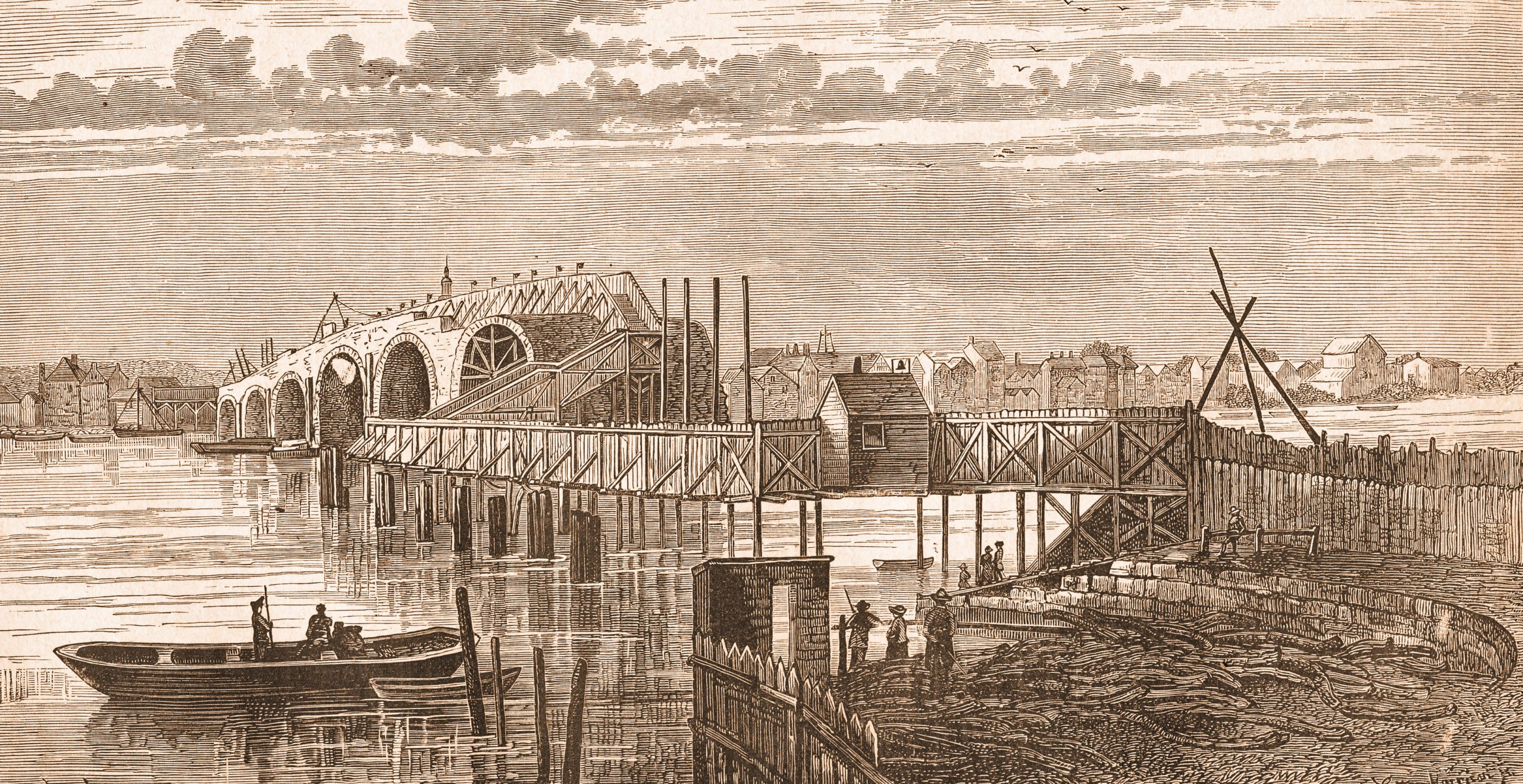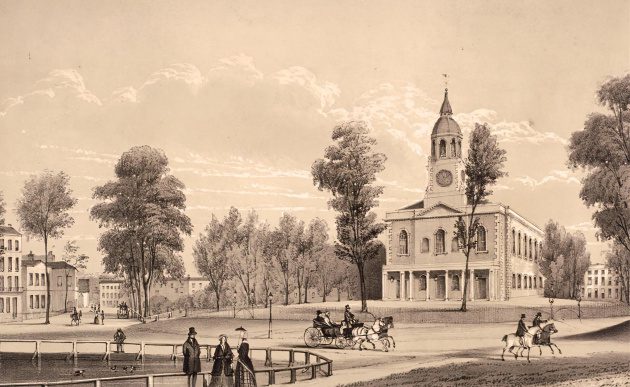The original Blackfriars Bridge

Blackfriars Bridge while under construction. It initially opened in 1766 for pedestrians only and this print shows it at that time, topped with a temporary wooden walkway connecting the bridge to the riverbank. It was completed and open to all traffic in 1769.
Mylne decided the angle of the bridge across the river according to the currents, to avoid turbulence for passing craft. The positioning was also to avoid Bridewell chapel on the north bank and the churchyard of Christ Church on the Southwark side. The roadway over the bridge widened out into new squares on each side, with new roads created leading up to them. On the City side was Chatham Place. The Fleet Ditch was covered over and relegated to a sewer, with Bridge Street (later renamed New Bridge Street) laid over it, meeting Fleet Street at Ludgate Circus. On the opposite side of the river was Albion Place, and from there Mylne laid out Great Surrey Street (now Blackfriars Road) some way south into St. George’s Fields to form a circus with the east-west Westminster Bridge Road. There he erected an obelisk that remains today. On the south bank, beyond the riverside wharves west of London Bridge, lay orchards and market gardens. Thereafter the fields were replaced by new housing developments that spread along Great Surrey Street.
Mylne prepared the agreements with the various building contractors and suppliers together with secretary of the bridge committee and fellow Scot John Paterson. Contracts were agreed in advance and could not be renegotiated even in the event of unexpected issues. There were two sets of prices for materials, however, depending on whether the country was at war (and hence supplies were at a premium) or at peace. The Seven Years War ended during the course of the work so the final cost was much lower than if prices had been agreed at wartime levels.
Despite many bridges built over rivers during medieval times there was still little experience in Britain of constructing one across a wide, fast-flowing tidal river such as the Thames, with a mud and shingle bed. Mylne used similar techniques for the building of the piers to that of Charles Labelye, the designer of Westminster Bridge, but also drove wooden piles of Baltic fir into the riverbed to give additional stability. These were driven in using a 14-hundredweight ram, mounted on a moored barge. The ram’s weight was lifted by horses walking in a circle on the barge. A massive caisson (floating box), weighing 250 tons, was constructed, floated, and dropped into place to provide dry, protected workspaces for the building of each of the eight piers. As one pier was completed the caisson was refloated and sunk again to work on the next.
Work began in 1760 and the foundation stone laid by the Lord Mayor that October. (At the same time, a major renovation of old London Bridge was taking place). Some Kentish ragstone from quarries around Maidstone was used but the bridge was primarily made from 36,000 tons of Portland stone, shaped by masons at a quarry in Dorset. Mylne faced similar supply problems to that encountered by Sir Christopher Wren when building his churches and St. Paul’s following the Great Fire. Blocks could take up to 16 months to arrive from Dorset by ship following the placing of orders and this delayed construction work.
In 1766 an additional £91,000 was raised. By that same year the bridge was complete to the point where it could be used by toll-paying pedestrians, two years later by horse-riders, and finally in November 1769 for carriages.
As always, the Thames watermen had opposed the idea of a new bridge, which would inevitably take business away from them, but this time they had no backing from the City itself. Worried about possible vandalism, in September 1766 Mylne negotiated compensation of £13,650 for the watermen, compared with a much higher amount at Westminster twenty years earlier.
The original intension was for the crossing to be named William Pitt Bridge after the Prime Minister. By the time of its completion Pitt had passed out of favour and it was instead named after the former Blackfriars monastery on its north bank. Following completion of the bridge Mylne continued to work on associated works for many years. These included new river embankments, requiring much negotiation with riparian landowners. The Inner and Middle Temple societies proved especially difficult, resulting in them gaining acres of new land.
Tolls of a halfpenny for each foot passenger and a penny on Sundays were initially levied to repay the loans. The bridge proved so popular that the cost was successfully recovered. The tolls were not universally popular, however. During the Gordon Riots of 1780 the toll booths were singled out for attack and were destroyed. The military shot dead some of those responsible. Charges were discontinued on weekdays in 1785 and all tolls ended in 1811.
Gleaming white Portland stone looked splendid when new but in the long-term proved too soft. The bridge was soon damaged by ice and barges as well as from pollution from outflow of the Fleet River. Repairs were carried out in 1793 in tougher Aberdeen granite. Over the years the road surface became pot-holed and in 1824 John MacAdam personally supervised its resurfacing in his new road-building technique.
The original Blackfriars Bridge was, on the whole, a great success. It eased traffic congestion, gave Londoners splendid views of the river and there was universal praise for its beauty. Mylne had managed to complete it in reasonable time given the scale of the project and at a far lower cost than Westminster Bridge.
Blackfriars Bridge was the beginning of a distinguished career for the young architect. The New River Company leased land at what was then known as Bagge’s Wharf, where the Dorset Theatre had once been located. The building of Mylne’s bridge involved alterations to the wharf, requiring negotiations between the architect and the company. In 1767 Mylne was appointed surveyor to the New River Company, thus starting a dynasty of Mylne family New River surveyors that lasted over 100 years. He was also appointed as surveyor to St. Paul’s Cathedral (during which time he was responsible for the funeral arrangements for Admiral Lord Nelson) and the Royal Hospital at Greenwich, as well as designing bridges and canals throughout the country.
London Bridge was rebuilt in 1831, the piers of which had long held back and slowed down the flow of the tides. The then faster-flowing river began to undermine Blackfriars Bridge. Extensive repairs were carried out in 1835. Deterioration continued and little money was thereafter spent on further repairs. Mylne’s once-magnificent bridge was in a poor state throughout the 1850s. During the following decade the decision to replace it was finally taken.
Sources include: Robert Ward ‘The Man Who Buried Nelson: The Surprising Life of Robert Mylne’; Peter Matthews ‘London’s Bridges’; John Summerson ‘Georgian London’; Jerry White ‘London in the Eighteenth Century’; Walter Thornbury ‘Old and New London’.
< Back to Bridges and Tunnels


